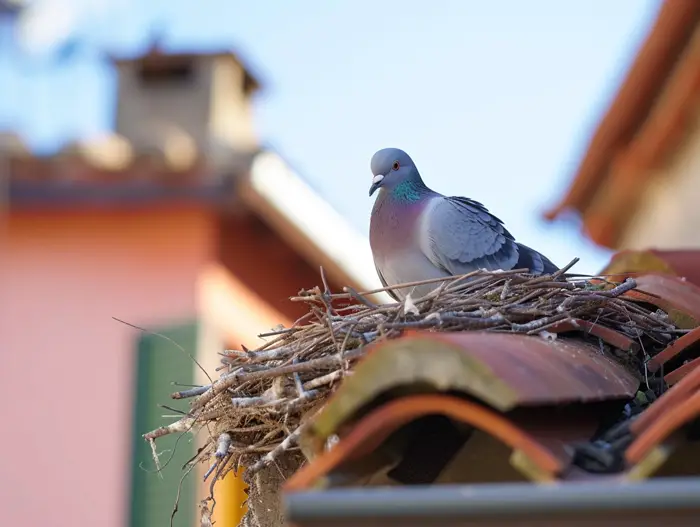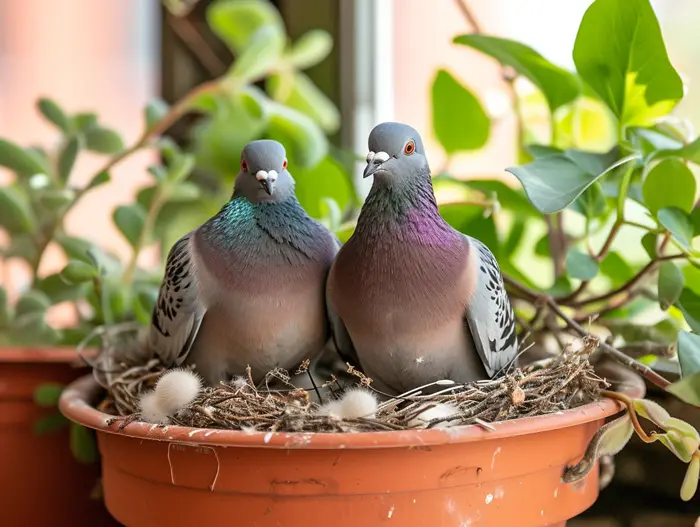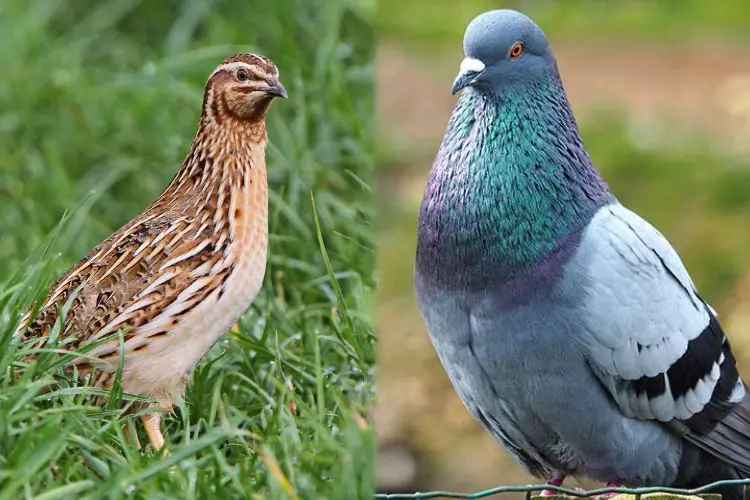The Dangers of Pigeon Nests: Health Risks & Costly Cleanup
Pigeons, those seemingly harmless birds that grace our parks and city streets, can actually be quite a nuisance. And it’s not just their constant cooing that can drive us up the wall. Pigeon nests, in particular, are a major cause for concern. As an expert in pest control, I’ve seen firsthand the havoc these nests can wreak. From health hazards to property damage, there are plenty of reasons why pigeon nests are bad news.
First and foremost, pigeon nests can pose serious health risks. These cozy little homes can become breeding grounds for bacteria, parasites, and disease-carrying pests. The accumulation of droppings, feathers, and other debris in and around the nests can contaminate the surrounding area, putting both humans and other animals at risk. Additionally, the presence of pigeons and their nests can exacerbate allergies and respiratory conditions, making it vital to address this issue promptly.
But it’s not just the health concerns that make pigeon nests a problem. These nests can also cause significant damage to buildings and structures. Pigeons are notorious for building their nests in the most inconvenient places, such as on rooftops, balconies, and even inside ventilation systems. Their constant nesting and roosting activities can lead to clogged drains, damaged insulation, and structural deterioration. Not to mention the unsightly mess they leave behind, which can be difficult and costly to clean up.
Pigeon nests may seem harmless at first glance, but they can have serious consequences. From health risks to property damage, it’s clear that these nests are bad news. In the following article, I’ll delve deeper into the specific problems associated with pigeon nests and provide practical solutions for dealing with this common pest issue. So, let’s dive in and explore why pigeon nests are such a cause for concern.
Health Risks Associated with Pigeon Nests
Pigeon nests may seem harmless at first glance, but they can actually pose significant health risks. These seemingly innocent structures can quickly become breeding grounds for bacteria, parasites, and disease-carrying pests. In this section, I’ll delve into the health hazards that are associated with pigeon nests.

1. Bacterial Infections:
Pigeon nests provide the perfect environment for the growth and multiplication of harmful bacteria. The accumulation of droppings, feathers, and debris can create a moist and warm setting, ideal for bacteria to thrive. These nests can harbor bacteria such as Salmonella, E. coli, and Histoplasma, which can cause infections in humans.
2. Parasitic Infestations:
Pigeons often carry parasites, such as fleas, ticks, mites, and lice. These pests can infest their nests and then spread to surrounding areas, posing a danger to human health. These parasites can bite humans, causing itching and discomfort. In some cases, they can even transmit diseases such as Lyme disease or bird mite dermatitis.
3. Respiratory Issues:
The accumulation of pigeon droppings and feathers in nests can lead to respiratory problems, particularly for individuals with allergies or pre-existing respiratory conditions. The fine dust present in the droppings can be easily inhaled, causing irritation and triggering asthma attacks. This can be especially problematic in enclosed spaces or buildings with poor ventilation.
4. Allergies:
Pigeon feathers, droppings, and debris can trigger allergies in susceptible individuals. The allergenic proteins present in these materials can cause symptoms such as sneezing, itching, watery eyes, and skin rashes. Those with existing allergies may experience heightened sensitivity when exposed to pigeon nests and their contents.
5. Structural Damage:
Aside from the health risks, pigeon nests can also lead to significant structural damage. The acidic nature of pigeon droppings can corrode building materials like metal, concrete, and stone over time. If nests are built near gutters, drains, or ventilation systems, they can cause blockages and compromised functionality.
It’s clear that pigeon nests should not be taken lightly. The health risks associated with these nests can have serious consequences. In the next section, I’ll provide practical solutions for effectively dealing with pigeon nests and minimizing these risks. Stay tuned!
Disease-Carrying Pests and Bacteria
One of the reasons pigeon nests can be so bad is because they can become breeding grounds for disease-carrying pests and bacteria. These unwanted visitors can pose significant health risks to humans. Let’s take a closer look at some of the dangers associated with these pests and bacteria.

Pests that pose health risks
Pigeon nests can attract pests such as lice, mites, fleas, and ticks. These tiny creatures thrive in warm and cozy environments like pigeon nests, where they have easy access to a constant supply of food and shelter. Unfortunately, when these pests make their way into our homes or workplaces, they can cause a range of health issues including skin irritations, allergic reactions, and in some cases, the transmission of disease. It’s important to keep these pests under control to protect our health.
Bacteria and diseases
The accumulation of droppings, feathers, and debris in pigeon nests can lead to an increase in harmful bacteria. Some of the bacteria commonly found in pigeon nests include Salmonella, E. coli, and Histoplasma. Exposure to these bacteria can lead to various health problems, including gastrointestinal issues, respiratory infections, and flu-like symptoms. It’s crucial to minimize contact with pigeon nests and take proper precautions when dealing with them to avoid exposure to these harmful bacteria.
Protecting yourself
To reduce the risks associated with disease-carrying pests and bacteria in pigeon nests, follow these practical tips:
- Avoid direct contact with pigeon nests and their contents.
- Wear protective clothing such as gloves, masks, and long-sleeved shirts when handling or cleaning pigeon nests.
- Clean and disinfect any areas that come into contact with pigeon droppings.
- Regularly inspect and remove any nests or debris from your property to prevent infestations and accumulation of bacteria.
By being aware of the potential dangers and taking proactive measures, we can protect ourselves and minimize the health risks associated with pigeon nests.
Remember: Prevention is key when it comes to dealing with disease-carrying pests and bacteria associated with pigeon nests. Stay informed, be cautious, and seek professional help if needed to ensure a safe and healthy environment.
Allergies and Respiratory Conditions

Now let’s dive into one of the major health risks associated with pigeon nests— allergies and respiratory conditions.
Pigeon nests can become a breeding ground for allergens, such as bird feathers, droppings, and dander. These allergens can cause a range of allergic reactions, including sneezing, coughing, wheezing, itching, and watery eyes. For individuals with pre-existing allergies or asthma, exposure to these allergens can exacerbate their symptoms and lead to more frequent asthma attacks.
In addition to allergens, pigeon nests can also harbor mold and fungi, which thrive in the warm and humid environment created by the nest. When these spores are inhaled, they can trigger respiratory issues, such as bronchitis or pneumonia.
Pigeon droppings themselves can also pose a significant risk to respiratory health. When dried droppings are disturbed, they can release harmful particles called respiratory irritants. These irritants can irritate the respiratory system, leading to coughing, chest tightness, shortness of breath, and even serious infections.
To protect yourself from allergies and respiratory conditions related to pigeon nests, there are a few steps you can take:
- Avoid direct contact with pigeon nests and droppings.
- Wear protective clothing, such as gloves and masks, when cleaning or removing nests.
- Clean and disinfect areas that come into contact with pigeon droppings, using appropriate cleaning products.
- Ensure proper ventilation in areas where pigeons may nest, to minimize the risk of mold growth.
Remember, prevention is key when it comes to maintaining a healthy environment. If you suspect an infestation or are experiencing persistent respiratory symptoms, it’s important to seek professional help to ensure the proper removal and sanitization of the affected area.
Now that we’ve explored the health risks associated with allergies and respiratory conditions, let’s move on to another important aspect— gastrointestinal issues caused by pigeon nests.
Structural Damage Caused by Pigeon Nests

Pigeon nests may seem harmless at first glance, but they can actually cause significant structural damage to buildings and other structures. Here’s how:
- Roof Damage: Pigeons tend to build their nests in sheltered areas, such as roof corners or under the eaves. Over time, their nests can block gutters and drainage systems, leading to water buildup and potential leaks. The accumulated moisture can weaken the roof’s integrity and cause rotting or corrosion.
- Blocked Ventilation: Pigeons often choose to nest near air vents or chimneys. As their nests become larger, they can obstruct the airflow and prevent proper ventilation. This can lead to a buildup of harmful gases, such as carbon monoxide, which poses a serious health risk. In extreme cases, it can even cause asphyxiation or fire hazards.
- Fecal Matter Accumulation: Pigeon droppings can accumulate rapidly in and around their nests. Not only is this unsightly and difficult to clean, but it can also lead to damage. The high acidity levels in pigeon droppings can corrode building materials like wood, metal, and stone. This can weaken structures, including roofs, walls, and balconies, rendering them unsafe and requiring costly repairs.
- Nest Debris: Pigeons often use twigs, feathers, and other materials to construct their nests. As these nests deteriorate over time, the debris can fall and collect in gutters, downspouts, or on flat surfaces. This can impede water flow, causing water to pool and potentially leading to water damage on roofs, ceilings, or walls.
It’s essential to address pigeon nests promptly to prevent further structural damage. Regular maintenance, such as removing nests and keeping potential nesting areas inaccessible, can help mitigate these risks. Seeking professional pest control services may also be necessary to handle pigeons and their nests safely.
Remember, by taking proactive steps to address pigeon nests, you can protect your property from potential costly repairs and ensure the safety of its occupants.
Clogged Drains and Damaged Insulation
Pigeon nests can cause more than just structural damage to buildings. They can also lead to clogged drains and damaged insulation. Let me explain why this is a cause for concern.
Clogged Drains: Pigeon nests are often built near gutters and drainage systems. Over time, these nests can accumulate a significant amount of debris such as twigs, feathers, and droppings. This debris can clog the drains, causing water to pool and accumulate. Clogged drains can lead to water damage, including leaks, which can be costly to repair.
Damaged Insulation: Pigeon nests are constructed with a variety of materials, including small twigs, feathers, and even trash. These nests can find their way into attics and other enclosed spaces in buildings, affecting the insulation. When pigeon nests are present in these areas, they can cause damage to the insulation materials, reducing their effectiveness. This can result in higher energy bills as the heating and cooling systems struggle to maintain the desired temperature.
Pigeon nests can also harbor pests, such as mites, fleas, and ticks, which can further exacerbate the problem. These pests can spread throughout the building, affecting the health and well-being of its occupants, particularly those with allergies or respiratory conditions.
The presence of pigeon nests can lead to clogged drains and damaged insulation, causing structural and financial issues for building owners. It’s essential to address pigeon nests promptly to prevent further damage and ensure the safety and comfort of those in the building. Regular maintenance and professional pest control services can help mitigate these risks.
And there you have it – the negative effects of pigeon nests on buildings don’t stop at structural damage. Clogged drains and damaged insulation can also be significant concerns. So, if you come across a pigeon nest, it’s best to take action sooner rather than later.
Unsightly Mess and Costly Cleanup
Pigeon nests not only pose health risks and structural damage, but they also create an unsightly mess that can be costly to clean up. In this section, I’ll explain why pigeon nests are such a nuisance and the challenges they present for property owners.

1. Accumulation of Droppings
One of the main reasons why pigeon nests are considered a nuisance is the significant accumulation of droppings. Pigeons are prolific poopers, and their droppings can quickly cover surfaces, such as rooftops, balconies, and windowsills. Not only is this unsightly, but it can also emit a foul odor and stain the affected areas.
2. Debris and Nesting Materials
Pigeons build their nests using a variety of materials, including twigs, feathers, and debris they find in their surroundings. Over time, these nests can become quite large and messy, with bits of trash and feathers scattered around. The debris can accumulate in gutters, downspouts, and air vents, leading to clogs and potential damage.
3. Allergens and Health Concerns
The accumulation of droppings and nesting materials in and around pigeon nests can pose health risks. Pigeon droppings contain pathogens, such as bacteria and fungi, which can cause respiratory infections and allergies, especially in individuals with weakened immune systems. The presence of dried droppings can also release harmful particulate matter into the air, further exacerbating respiratory conditions.
4. Costly Cleanup and Maintenance
Cleaning up pigeon nests can be a tedious and costly endeavor. Depending on the size and location of the nest, it may require professionals to safely remove the nests, clean the affected areas, and disinfect the surroundings. The cleanup process often involves specialized equipment and protective gear, adding to the overall expenses.
5. Preventative Measures
To avoid the unsightly mess and costly cleanup that comes with pigeon nests, it’s crucial to take preventative measures. This includes regular maintenance, such as sealing off potential entry points, cleaning up droppings promptly, and installing deterrents like spikes or netting to discourage pigeons from nesting on your property.
By understanding the challenges associated with pigeon nests, property owners can take proactive steps to prevent their formation and minimize the unsightly mess and costly cleanup they entail. Stay tuned for the next section, where I’ll delve into the environmental impact of pigeon nests.
Conclusion
It is clear that pigeon nests can be detrimental in various ways. Not only do they pose health risks due to the pathogens present in their droppings, but they can also cause structural damage to buildings. The accumulation of droppings and nesting materials can lead to clogged drains and potential costly repairs. Additionally, the unsightly mess created by pigeon nests can be a nuisance and require expensive cleanup.
To avoid these issues, regular maintenance and preventative measures should be implemented. This can include sealing off potential nesting areas, installing deterrents, and conducting routine inspections. By taking proactive steps, we can minimize the formation of pigeon nests and mitigate the associated problems. It’s important to address the issue promptly to protect our health, property, and overall well-being.







